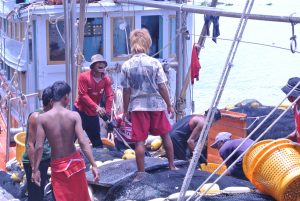After a year in which it has mostly kept the coronavirus under control, Thailand has seen a sudden alarming spike in coronavirus infections. On December 20, Thai health authorities announced a record 689 infections, including 516 cases announced the day before.
That is by far the country’s highest daily tally, bringing the country’s total to just over 5,000 confirmed infections. In January 2020, Thailand was the first country outside China to report a case of COVID-19, but thanks to strict border and quarantine controls has so far reported just 60 deaths from the disease.
The new infections are all linked in one way or another to the Klang Koong shrimp market in Samut Sakhon, a coastal province southwest Bangkok, which is home to many migrant workers. The authorities have imposed a two-week lockdown in Samut Sakhon in an attempt to gain control of the outbreak.
The first four cases linked to the shrimp market were identified on December 18, and within two days, health officials said they had tested 1,443 people, of whom 689 had tested positive, mostly migrant workers from Myanmar. On December 21, the government announced a further 382 infections, 360 of them involving migrant workers.
The local authorities are now in the midst of testing up to 40,000 people in Samut Sakhon and nearby provinces, with over 10,000 tests to be conducted by December 23. But cases connected to the market are now popping up elsewhere in the country, raising fears that the virus has already spread beyond the region of the initial outbreak.
The outbreak shines a spotlight on Thailand’s floating population of migrant workers, who have long been central to the country’s economy, doing dangerous or low-paid work that many Thais are no longer willing to perform. According to one estimate, there are roughly five million migrant workers in Thailand, but only about half of them are legally documented. Low-paid migrant labor is particularly vital to Thailand’s seafood industry, which employs tens of thousands of low-paid workers from Myanmar and Cambodia.
Despite the important economic role played by migrant labor, the Thai government has failed to develop a system to normalize and regulate their employment and immigration status. This means that hundreds of thousands have fallen between the cracks of the official screening and contact tracing programs intended to maintain control of COVID-19.
The majority of the migrant workers in Samut Sakhon are from Myanmar, which has in recent months seen a rapid spread of COVID-19, making it the third-highest in Southeast Asia, with 116,134 confirmed cases and 2,443 deaths as of December 20.
Populations of migrant workers have posed infection risks in other parts of Southeast Asia. Even in Singapore, where migrant workers are registered with the government, the virus spread earlier in the year in crowded migrant worker dormitories. A recent study found that infections were three times higher among migrant workers in Singapore than the rest of the population. Similar outbreaks among migrant workers have also been seen recently in Malaysia.
The infections also highlight the risks posed by the long border between Thailand and Myanmar, which has been porous to flows of undocumented trade and labor migration. Earlier this month, there were scattered outbreaks of the disease in northern Thailand after several people crossed the border illegally from Myanmar. The threat of crossborder contamination has also contributed to China’s reported construction of a barbed-wire fence along its border with Myanmar.
Although the Thai government has moved to seal off the border with Myanmar in the wake of the shrimp market cluster, people reportedly continue to cross, driven in many cases by necessity. As per the New York Times, “undetected cross-border movement continues, including people who want to avoid Thailand’s mandatory two-week quarantine.”
For years, Thailand’s economy has benefited immensely from the crossborder mobility of low-cost labor. Now, in pandemic times, it looms as a point of vulnerability.













